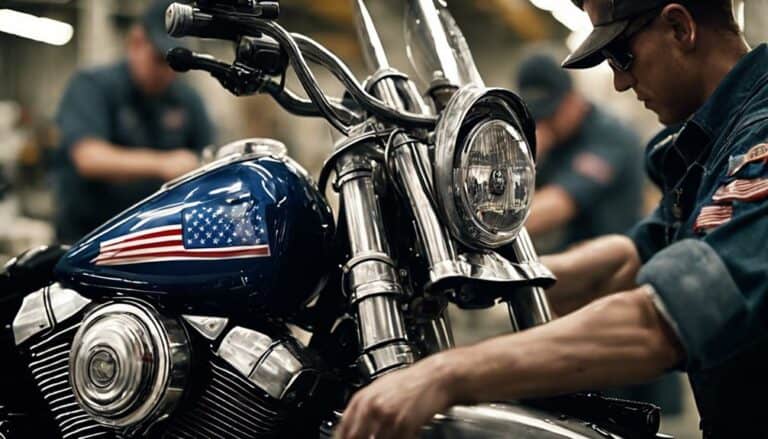When it comes to Harley-Davidson's production, the saying 'you are what you eat' takes on a whole new meaning.
The question of what percentage of Harley Davidson is truly made in America might surprise you.
As you explore the intricacies of Harley's manufacturing process, you'll uncover a web of global connections and domestic roots that paint a fascinating picture of American craftsmanship in the modern age.
Key Takeaways
- Approximately 70% to 85% of Harley-Davidson motorcycles sold in the US contain American-made parts.
- Engines for US bikes are manufactured domestically, reflecting a commitment to American craftsmanship.
- Harley-Davidson aims to maintain a significant proportion of American-made components while strategically sourcing globally.
- The brand balances tradition and innovation, emphasizing American production for the domestic market.
The History of Harley-Davidson Manufacturing
Harley-Davidson's manufacturing history showcases a strategic blend of domestic and international sourcing for its iconic motorcycles. As a Milwaukee-based American motorcycle brand, Harley-Davidson has a rich history of manufacturing its bikes with parts made in America. Engine manufacturing for US market bikes primarily occurs at Harley's Wisconsin factory, ensuring a touch of domestic craftsmanship in each ride.
While the company sources components globally from countries like Taiwan, Italy, Germany, China, Mexico, and Japan, it maintains a balance by incorporating American-made components into the majority of its motorcycles. This blend of sourcing allows Harley-Davidson to meet quality and cost considerations while preserving its American heritage in the production process.
Over the years, Harley-Davidson has honed its manufacturing practices to cater to the US market's preferences, solidifying its reputation as a top choice for riders seeking a mix of tradition and innovation in their motorcycles.
Percentage of American-Made Harley Parts
With a majority of American-made parts comprising between 70% to 85% of Harley's motorcycles sold in the USA, the brand's commitment to domestic manufacturing remains a key pillar of its production strategy.
While Harley Davidson sources specific components like brakes from various countries outside the USA to meet production demands, engines for bikes sold in the US are manufactured domestically at Harley's Wisconsin factory.
Although some engine parts may be sourced globally, Harley-Davidson ensures a significant percentage of American-made components in their motorcycles, reflecting their dedication to supporting local manufacturing and upholding the quality associated with American craftsmanship.
This strategic approach not only enhances the brand's reputation but also resonates with consumers who value authenticity and the tradition of American manufacturing.
Factors Influencing Harley's Manufacturing Locations
Factors influencing the manufacturing locations of Harley motorcycles are driven by a complex interplay of cost efficiency, supply chain dynamics, and quality standards.
- American-made Parts: Harley-Davidson aims to incorporate a significant percentage of American-made parts in its motorcycles for the USA market.
- Global Sourcing: Parts for Harley motorcycles are sourced from various countries like Taiwan, Italy, Germany, China, Mexico, and Japan.
- Quality Considerations: Specific components such as brakes can be sourced from different countries based on both cost and quality considerations.
- Manufacturing Locations: While engines for Harley bikes sold in the US are manufactured in the USA at Harley's Wisconsin factory, some parts may still be sourced internationally to meet production demands.
Harley-Davidson strategically balances the sourcing of components from around the world while ensuring the final products maintain a level of American-made parts to cater to the preferences of the USA market. This approach allows for flexibility in production while upholding quality standards and cost efficiency.
Impact of Globalization on Harley-Davidson
Globalization has significantly impacted Harley-Davidson's manufacturing strategies, reshaping its supply chain dynamics and production locations. The company, known for its American manufacturing heritage, faces the challenge of balancing the use of American-made parts with cost management and quality assurance in a globalized market. Harley-Davidson's strategic shift to move some production to Thailand was a response to EU tariffs, allowing it to maintain its American-made promise for U.S. customers while managing costs effectively. Despite operating globally, the company continues to emphasize its brand identity rooted in American manufacturing.
| Impact of Globalization on Harley-Davidson | ||
|---|---|---|
| Key Aspects | Implications | Strategic Response |
| Global Operations | Enhanced reach | Cost-effective sourcing |
| Quality Assurance | Consistent standards | Stringent supplier criteria |
| Brand Identity | Differentiation | Emphasis on heritage |
Harley-Davidson's ability to adapt to the challenges brought by globalization while staying true to its American roots showcases its strategic flexibility and commitment to quality and brand integrity.
Future Outlook for Harley's American Production
Amidst the evolving landscape of global manufacturing and supply chains, Harley-Davidson remains steadfast in its commitment to maintaining a significant percentage of American-made parts in the motorcycles it sells in the USA. The company's future plans reflect a strategic approach to balance its manufacturing identity and cost efficiency while upholding its 'Made in America' reputation.
Key points for Harley's American production outlook include:
- Harley-Davidson aims to maintain 70% to 85% American-made parts in bikes sold in the USA.
- The company strategically sources parts globally while focusing on preserving its American manufacturing identity.
- Despite international operations, Harley emphasizes its commitment to American production for its domestic market.
- Future plans include ensuring a significant percentage of American-made components in Harley motorcycles.
Harley Davidson's approach underscores a dedication to both quality and heritage, ensuring their motorcycles remain synonymous with American craftsmanship while navigating the challenges of a globalized marketplace.
Conclusion
In conclusion, Harley-Davidson's commitment to American manufacturing is like a sturdy foundation, with 70% to 85% of parts made domestically. Despite sourcing from various countries, engines are proudly made in the USA.
As globalization continues to shape the industry, Harley-Davidson remains steadfast in its dedication to American production. The future looks promising for Harley's legacy of American craftsmanship.

